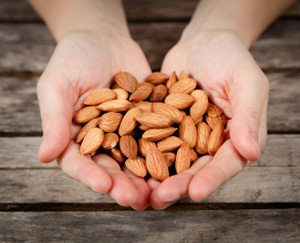Penn Herb Wellness Guide
Smart Snacking Decoded

Done right, snacking can be a way to add healthy foods to the diet and keep excess pounds at bay, fueling us through long days of work and family activities. Research bears this out: snacking more times per day is associated with a healthy body weight, overweight adults tend to snack less, and snackers routinely eat more fiber, vegetables, and fruit than nonsnackers.
Our tips and ideas will put snacking to work for you, and lead you down the positive path to health and wellness.
Master the macros
Macronutrients give us energy, or calories, in the form of protein, carbohydrates, and fat. For healthiest snacking, pick items that contain a mix of protein, complex carbohydrates, and/or healthy fats. For example, instead of a plain piece of fruit, try a piece of fruit and a small handful of almonds or walnuts. Here are some other good snacking options:
- A banana with a tablespoon of peanut butter
- 1/2 cup plain Greek yogurt with 1/2 cup blueberries or strawberries
- Chopped raw carrots, peppers, celery, broccoli, or cauliflower with hummus or white bean dip
- 1/2 cup cereal—pick one with at least 6 grams of protein and 4 grams of fiber per serving—with skim or low-fat milk or yogurt
- An energy or granola bar with at least 8 grams of protein, 3 grams of fiber, and fewer than 200 calories
- 1/2 of a 100% whole grain bagel with low-fat cream cheese or hummus
- 6 whole grain crackers—rye crackers are crisp and tasty—topped with 1/3 of a sliced avocado and sliced tomatoes or cucumbers
It’s important to remember that alcohol can contribute calories to the diet as well. For optimal health, it should be used only in moderation—no more than one drink per day for women or two per day for men—or not at all. One drink is 12 ounces of beer, 5 ounces of wine, or 1.5 ounces of hard liquor.
Mix in more micros
Micronutrients are the vitamins, minerals, and phytonutrients, such as beta carotene, vital to good health. Minimally processed, whole plant foods offer the highest variety and amounts of micronutrients. The closer a food looks to when it came out of the ground or off the tree or vine, the more micronutrients it will have.
For example, fresh or frozen blueberries are a better source of micronutrients than a blueberry muffin. Another bonus of whole plant foods is that they tend to be lower in calories, so you won’t break the calorie bank snacking on them.
Factor in fiber
Fiber is neither a macro- nor micronutrient, but fiber-rich diets are well known to lower the risk of numerous chronic diseases, including heart disease and diabetes, keep our digestive tracts in top working order, and help us stay full, which aids in weight maintenance. For more fiber, reach for
- vegetables,
- fruit,
- whole grains,
- beans (try bean dip or hummus), and
- nuts (keep servings to a small handful).
Tip: To make sure your grains are whole, read the ingredient list. The word “enriched” is a tip-off that a product is not whole grain.
Keep calorie goals in mind
Routinely reaching for fatty, salty, nutrient-poor snacking options may add unwanted inches to our waistlines, so pick your snacks with care. This is especially true if you are trying to lose weight. For example, a woman on a weight-loss plan may have a 1,500 to 1,600 daily calorie goal. About 400 of those calories can go toward snacks, so if you have two to three snacks per day, plan for about 135 to 200 calories per snack.
Here are some examples of snacks that fall within these guidelines:
- 3/4 cup no-fat Greek yogurt with 1/2 sliced banana
- 1/2 cup high protein cereal with 1/2 cup skim or soy milk
- 1 ounce—a small handful—of walnuts, almonds, or other nuts
- 1/2 cup edamame—steamed soy beans—lightly salted and with a teaspoon drizzle of olive oil (try a squeeze of lemon for an extra kick)
- 1 scoop protein powder, 1/2 cup sliced fruit, and ice and water to blend
All in all, snacking has a lot going for it. It can keep your body consistently fueled with healthy foods, which makes for more energy, and a healthier, happier you!
(J Am Diet Assoc 2011;111:17304; J Am Diet Assoc 2011;111:1898903)
Copyright 2026 TraceGains, Inc. All rights reserved.


